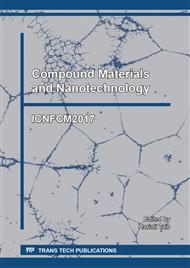p.3
p.8
p.15
p.20
p.26
p.33
p.39
p.47
Solvothermal Synthesis of Magnesium Oxide-Substituted Hydroxyapatite Nanoparticles as Antibacterial Nanomaterial for Biomedical Applications
Abstract:
In order to generate bactericidal effects in the oral cavity, several alternatives have been studied, including the use of silver nanoparticles but presents problems such as toxicity and low biocompatibility. From human-inspired systems, the antibacterial efficiency of the hydroxyapatite nanoparticles depends strongly on the type of composites and nanoparticles size. Several types of hydroxyapatite nanoparticles and their derivatives have received much attention for their antibacterial potential effect, including magnesium oxide nanoparticles. The purpose of this research was to produce a biocompatible antimicrobial compound of nanoparticles of hydroxyapatite doped with magnesium oxide to generate antibacterial effects in the oral cavity. The solvothermal method was used to produce hydroxyapatite nanoparticles doped with magnesium oxide. Antibacterial activity of as synthesized nanopowders against cariogenic Streptococcus mutans was tested by the CLSI disk-diffusion method. As result of this research, hydroxyapatite doped with magnesium nanoparticles (nHAMg) were successfully synthetized by the solvothermal method where in structural characterization indicates magnesium substitution and FTIR analysis gives a broader spectrum of the nHAMg when compared to pure nHA and crystallite size of nHA decreased. Furthermore, results of antibacterial assays showed that nHAMg allow to inhibit the grown of S. mutans by showing a halo of inhibition around the discs. Moreover, this antibacterial activity is enhanced by the addition of silver ion in an amount below to known toxic concentration, showing a synergetic effect that can further potentiate even more these HA nanoparticles. This work demonstrates that solvothermal method is a promising synthesis way for producing antibacterial hydroxyapatites nanoparticles for biomedical applications such as oral tissue regeneration.
Info:
Periodical:
Pages:
8-14
Citation:
Online since:
November 2017
Price:
Сopyright:
© 2017 Trans Tech Publications Ltd. All Rights Reserved
Share:
Citation:


